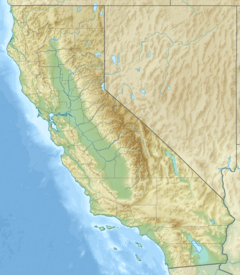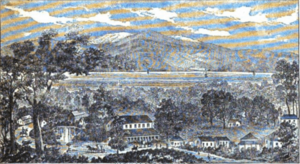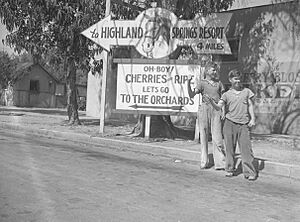Highland Springs, Lake County, California facts for kids
Quick facts for kids
Highland Springs
|
|
|---|---|

Arsenic and Ems springs, at Highland Springs, Lake County, California
|
|
| Country | United States |
| State | California |
| County | Lake County |
| Elevation | 1,483 ft (452 m) |
Highland Springs, once known simply as Highland, was a popular resort built around natural mineral springs in Lake County, California. In the 1800s, people believed the mineral waters could help them feel better. The resort grew big enough to host 200 guests, who also enjoyed the beautiful mountain views.
However, in the 1920s, the resort became less popular. Part of the hotel burned down, and the property changed owners several times. Eventually, Lake County bought the land and created the Highland Springs Reservoir. Today, the reservoir is part of the Highland Springs Recreation Area, a fun place managed by the county.
Contents
Where is Highland Springs Located?
Highland Springs is about 5 miles (8 km) southwest of Kelseyville. It sits on the edge of the mountains, next to the flat Big Valley area. This area is west of Clear Lake (California). The elevation here is 1,483 feet (452 meters) above sea level.
You can reach Highland Springs by taking Highland Springs Road. This road branches off from the Lakeport–Hopland Road (CA175). It goes through Highland Springs and then turns north. It eventually connects to CA29 / CA175 near Lakeport.
In the past, people traveled to the springs by train and then by stagecoach. The journey was described as very scenic. Before modern roads like CA175 were built, Highland Springs was an important stop. It was on the main road between Hopland and Kelseyville.
The Special Mineral Springs
In 1910, there were 11 different mineral springs at Highland Springs. Most of these springs were found near the hotel, along the western bank of a creek. All the springs had natural fizz, like soda water, and their basins were stained by iron. Some also had small amounts of lime.
The springs mainly flowed from crushed sandstone and shale. They were known for their fizzy, carbonated water. People believed these waters had healing powers.
Different Types of Springs
- Seltzer Spring: This spring was about 160 yards (146 meters) southeast of the hotel. Its water was cool, around 59°F (15°C), and flowed slowly. It was very fizzy and left a lot of iron deposits.
- Neptune Spring: This was the southernmost spring along the creek, about 100 yards (91 meters) west of the hotel. Its water was warmer, around 66°F (19°C). It was used for drinking and also piped to a small bathing pool.
- Diana and Magnesia Springs: These springs were close together, a bit north of Neptune Spring. Diana Spring's water was warmer, about 80°F (27°C), and flowed faster. It supplied a small bathing pool. Magnesia Spring was cooler, around 68°F (20°C), and its water was mainly for drinking.
- Bathhouse Springs: A large amount of water flowed from beneath a platform, supplying a bathhouse and a swimming pool across the creek. The water here ranged from 72°F to 82°F (22°C to 28°C).
- Arsenic and Dutch Springs: These two springs were at the northern end of the spring line. Arsenic Spring had milky water, while Dutch (or Ems) Spring had crystal clear water. Their temperatures were around 68°F (20°C) and 72°F (22°C).
A Look Back at Highland Springs Resort
Highland Springs started as a resort in the 1870s. It even had its own post office at different times. In 1885, Dr. C.M. Bates, the owner, advertised Highland Springs Sanitarium as the "Switzerland of America." He said the mountains protected it from cold winds and fogs. He also claimed the mineral waters were as good as any in the United States or Europe.
An 1890 guide described the resort as having a large hotel and many nice cottages. There was also a stable where guests could rent horses and carriages. They could take scenic drives to nearby towns like Lakeport and Kelseyville. A clean mountain stream flowed past the hotel, full of fish. The climate was mild and dry, and the air was fresh. The guide also mentioned that the area was good for people with lung problems.
By 1910, the resort had a big wooden hotel and several cottages. They could host up to 200 guests. In 1914, the resort could accommodate 315 guests and even had a doctor during the summer. The owners also kept 2,300 acres (930 hectares) as a place for fishing and hunting. The spring water was not bottled for sale.
The Resort's Decline and New Purpose
The popularity of the resort's mineral waters started to fade in the 1920s. A fire damaged part of the hotel. The property was sold several times, first to someone who wanted to open a casino, then to a sheep rancher, and finally to a doctor who made the remaining hotel into his family home.
In the 1960s, Lake County bought the property. They built dams on Highland Creek and Adobe Creek, flooding the old resort land. This created the Highland Springs Reservoir.
Highland Springs Recreation Area Today
Today, the Highland Springs Recreation Area covers about 2,500 acres (1,012 hectares). It is managed by the County of Lake Watershed Protection District. The area includes both Highland Springs Reservoir and Adobe Reservoir.
The landscape features open grasslands, scrub, and oak forests. Steeper hills are covered in chaparral, a type of dense shrubland. Visitors can enjoy many outdoor activities here. These include hiking, horseback riding, mountain biking, and disc golf. You can also go paddling, fishing, hunting, picnicking, and swimming.
The Highland Springs Disc Golf Course was created in 1980. The reservoir is filled with warm-water fish like largemouth bass, sunfish, bluegill, catfish, and bullhead. It's a great place for outdoor adventures!





